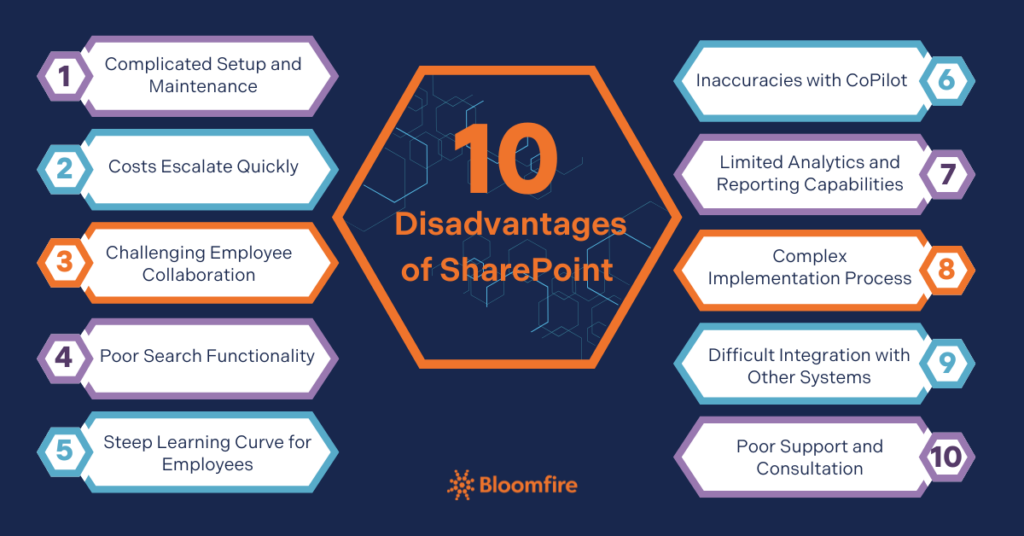The Disadvantages of SharePoint: Is It a Fitting Choice in 2025?

Many companies turn to SharePoint as a knowledge-based solution. Its connection with the Microsoft suite and its popularity make the platform seem perfect at first glance. However, the disadvantages of SharePoint—combined with the fact that it’s not a purpose-built knowledge management solution—make it a less-than-ideal choice for many businesses. This is especially true when your goal is to improve searchability and engagement.
While SharePoint is a customizable and powerful tool for versatile document management and collaboration, the advantages that make it popular come with disadvantages that can also make it challenging as a solution for enterprise knowledge management. Depending on your company’s unique IT structure, there may be better choices for your organization. To make an informed decision, consider these SharePoint downsides.

1. Complicated Setup and Maintenance
A common complaint among organizations is the lack of a simple approach to setting up Sharepoint’s knowledge base setup and long-term maintenance. The platform’s reputation stems from its robust and highly configurable nature.
Customizability is one of its major attractions–from configuring site collections and managing user permissions to tailoring workflows and integrating with other systems–each step demands careful planning and execution. However, this level of customization warrants a highly technical requirement from personnel, so you’ll likely have to work with a developer to get the functionality you need.
The main issue is that resolving platform-related tasks and concerns often takes longer with SharePoint developers than managing them independently with a solution like Bloomfire. It’s also essential to consider that knowledge management and communication programs aren’t set-it-and-forget-it solutions. As a result, maintenance can be just as complex as the setup and require continuous investment from SharePoint developers.
A Robust SharePoint Alternative!
Bloomfire’s KM system capabilities make it a solid choice for top companies.
Book a Meeting
2. Costs Escalate Quickly
SharePoint’s total cost of ownership (TCO) can be a significant investment for organizations, often exceeding initial expectations. While Microsoft offers various licensing plans, these are just the tip of the iceberg. Beyond the per-user or per-server fees – especially the additional $30 per user for using tools like Copilot with SharePoint – organizations frequently underestimate the expenses associated with implementation, customization, ongoing maintenance, and specialized personnel.
Developing custom solutions, integrating with existing systems, and ensuring seamless workflows often require engaging experienced SharePoint developers or consultants, which drives project costs considerably. Furthermore, the platform’s complexity can lead to extended implementation timelines, impacting productivity and time to value. Regular updates and migrations also require careful planning and resources, adding to the long-term financial commitment.
In addition, individual training costs will be expensive if you have more than a few employees. It’s also vital to consider the time and expense of this endeavor. Microsoft recommends SharePoint training for weeks or months to allow users to learn and practice specific tasks. This time spent on training leads to added costs.
3. Challenging Employee Collaboration
A majority of employees (64%) lose at least three hours per week due to poor collaboration, with a significant portion (20%) losing even more—up to six hours. If tools and applications contribute to this problem, the actual lost productivity, not to mention the cost of the deduction, doubles significantly. Unfortunately, SharePoint contributes to this issue.
SharePoint is often touted as a leading platform for collaboration, especially among remote teams, but some users find its collaborative features lacking. While it offers tools like document co-authoring and shared workspaces, its complexity and poor search functionality (see more below) can hinder seamless group work.
Furthermore, SharePoint’s reliance on centralized control can sometimes stifle collaboration. While this structure is essential for governance and security, it can also create bottlenecks and slow decision-making processes. In some cases, users may need to go through multiple layers of approval or wait for administrators to grant permissions before collaborating on a project.
4. Poor Search Functionality
When companies depend on SharePoint to store and retrieve data, employees expect quick results. After all, employees spend about 25% of their workday or about 9.3 hours a week searching for information–a figure companies opt to reduce.
However, SharePoint’s search capabilities are notoriously limited and highly dependent on how admins and SharePoint developers have built it out, resulting in fruitless searches and considerable time loss. Many employees spend several hours a week browsing through folders to find what they need or contacting coworkers to ask for document links. Reasons for search issues range from the system’s reliance on folders for structure and keywords not matching file names to the system’s failure to index content or limitations of full-text search capabilities, but the results are the same.
SharePoint intranet’s best practices and workflows frequently break down even if these settings are repaired. Files can be misplaced in the wrong folders, making them difficult to find. Limited search functionality makes retrieving these files even more complicated, so employees start cutting corners. Additionally, because SharePoint and OneDrive are closely connected, employees may find it more challenging to sift through incomplete or outdated documents than those that are finalized and vetted.
As a result, SharePoint can become so messy and disruptive to efficiency that using the platform can sometimes be more of a hindrance than a benefit. Moreover, misplaced files can make it difficult to keep information secure in your knowledge base.
5. Requires a Steep Learning Curve for Employees
One of SharePoint’s most notorious disadvantages is its steep learning curve, especially for new users. Nearly half of the organizations surveyed by AIIM found SharePoint challenging to use, with 43% rating it as “difficult” or “very difficult.” Unlike more streamlined knowledge base solutions, SharePoint’s breadth of functionality, while advantageous for customization and comprehensive solutions, can overwhelm new users.
For one, SharePoint customizability means that employees must understand the platform’s various features to use them effectively. Employees typically need training to avoid productivity loss when using SharePoint.
Mastering SharePoint requires familiarity with its interface and an understanding of underlying concepts like site architecture, permissions, and content types. Given its complex landscape, the interface’s nonintuitive navigation doesn’t help either.
The challenge of learning SharePoint is further compounded by its continuous evolution. Microsoft regularly updates the platform with new features and improvements, requiring users to adapt and acquire new skills. While these updates enhance SharePoint’s capabilities, they can also add to the learning curve, especially for those struggling to keep up.
6. Copilot (SharePoint’s AI-Powered Tool) Can Be Inaccurate
Microsoft’s Copilot, the AI-powered tool designed to enhance SharePoint experiences, has generated excitement and high expectations upon its release. After all, using artificial intelligence to improve internal search further is not just a knowledge management trend–it’s an undeniable necessity today.
However, some users have reported inconsistencies and inaccuracies in its responses, mainly because it pulls from content that can be redundant, outdated, and trivial within each employee’s scope of accessible content. This has led to questions about the Copilot’s reliability for crucial tasks and the need for careful oversight when using its output.
The complex nature of natural language processing, coupled with the vast amount of data within SharePoint environments, can present challenges for Copilot’s AI. Plus, at $30 per user per month, Copilot offers questionable value, frequently drawing upon incomplete, outdated, and contradictory sources.
7. Limited Analytics and Reporting Capabilities
SharePoint’s native analytics primarily focus on basic usage metrics like page views, popular content, and search queries. This provides a general overview of site activity but may lack the depth to understand user behavior and content effectiveness. Hence, SharePoint may be a bad choice if your business is focused on deeper insights like content gaps or monitoring knowledge utilization and the efficiency anchored to it, as it can counteract employee productivity.
Additionally, the reporting dashboards may not offer the flexibility for business owners to self-serve in customizing data visualization or creating specific reports needed for in-depth analysis. Plus, even with limited insights, specialized technical expertise is often required to generate more comprehensive reports.
8. Complex Implementation Process
While SharePoint’s flexibility allows for extensive customization, it requires more development effort and meticulous testing. Custom branding, unique functionalities, and intricate permission structures contribute to the duration of the implementation. Migrating existing content, a common requirement for many organizations, can add to the complexity and time involved.
Estimating a precise timeframe is challenging, as it heavily depends on the intricacies of the desired solution. Cumbersome implementations involving meticulous integrations, bespoke designs, and extensive content migration can last several months. It’s common for larger organizations with particular requirements to dedicate 3-6 months, or even longer, to a full-fledged SharePoint knowledge base implementation.
9. Challenging Integration With Other Systems
Users often find SharePoint’s integration with other systems and external apps a significant hurdle. While not impossible, the process can be complex and time-consuming. Many organizations report difficulty seamlessly connecting SharePoint with their existing CRM (customer relationship management), ERP (enterprise resource planning), or other business-critical applications. This can lead to data or information silos, workflow disruptions, and reduced productivity as users struggle to navigate between different platforms.
The differences in data formats, protocols, and security models often drive these challenges. Bridging these gaps frequently requires custom coding, third-party connectors, or middleware solutions, which can add significant costs and complexity. Furthermore, maintaining these integrations can be an ongoing effort, as updates to one system may impact the functionality of others.
10. Poor Support and Consultation
Reports of rampant issues of poor support and subpar consultation services are cited as glaring disadvantages of SharePoint. These problems include long wait times, unhelpful responses, and a lack of personal consultation on knowledge management strategy. Users also noted that the provider’s documentation and training are inadequate and outdated, making it difficult to troubleshoot even the most basic problem independently.
Additionally, you need to employ full-time SharePoint engineers or consultants to support their initiatives, which promotes reliance and dependence in addressing the challenges of implementing a knowledge management system. This is a stark contrast to Bloomfire, wherein an award-winning team of knowledge management and change management experts will guide you through a successful implementation process and partner with you long-term to optimize adoption and ROI.
Is SharePoint the Right Choice for Your Organization?
The global knowledge management software market is expected to more than double in size by 2032, reaching $54.7 billion. This rapid growth is driven by organizations’ increasing need to manage information or data effectively and improve decision-making by investing in true-to-form knowledge management solutions. Unfortunately, SharePoint isn’t one since it prides itself on document management, which is only one part of KM.
If you’re considering using SharePoint because you’re familiar with the name and Microsoft’s brand, you could be making a mistake. While SharePoint seems like an easy option, its complex makeup can make it challenging to assess knowledge gaps and provide easy access to company information.
You may go for a more dedicated knowledge management system under the following if you’re looking for the following conditions:
- An intuitive and user-friendly knowledge base
- A proper knowledge management solution with robust search capabilities, content authoring tools, version control, and built-in AI capabilities instead of separate add-ons
- A cost-effective option with outright pricing
- A KM system with seamless integration into third-party apps
- A knowledge base that conveniently supports employee collaboration
Before choosing SharePoint, consider the resources you are willing to commit to the platform and explore options that may suit your needs. SharePoint is one of many platforms available for storing and sharing information.
A Fitting Alternative to SharePoint
A more robust, easy-to-use, and flexible knowledge management system, like Bloomfire, can meet your knowledge storage and sharing needs without the shortfalls of SharePoint. Bloomfire’s knowledge management platform gives you one central, searchable place for information and insights so you and your team members can do your best work. Plus, with advanced search capabilities and the ability to follow posts, authors, tags, search terms, and more, delays are a thing of the past. Learn more about how Bloomfire stacks up with SharePoint.
Knowledge Management Simplified!
Avoid the hassle of a complex KM solution and use your knowledge assets the right way.
Explore Bloomfire

How to Improve Customer Service in Call Centers: 21 Ways to Enhance Contact Center Experience

Innovative Ways Companies Are Using Knowledge Management

How to Implement a Knowledge Check in 6 Steps

Estimate the Value of Your Knowledge Assets
Use this calculator to see how enterprise intelligence can impact your bottom line. Choose areas of focus, and see tailored calculations that will give you a tangible ROI.

Take a self guided Tour
See Bloomfire in action across several potential configurations. Imagine the potential of your team when they stop searching and start finding critical knowledge.